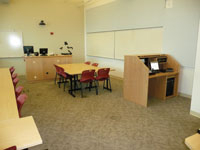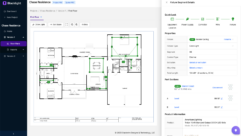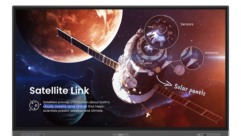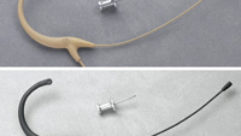

Installation Spotlight: Teach and Post
Jul 14, 2009 4:31 PM,
By Bennett Liles
De Anza College, Cupertino, Calif.
At De Anza College in Cupertino, Calif., a new multimedia classroom was outfitted with an AV system that would allow faculty members to record their lectures so that students could view them online at a later time.
When De Anza College in Cupertino, Calif., decided to create a classroom for environmental science courses that allowed faculty members to record their lectures for students to view on-demand at home, De Anza College Video Systems Engineer Edward Breault went to work on a system that would provide the maximum in format selection with the minimum in faculty equipment operation. The project was undertaken in an existing multimedia classroom with a projector, document camera, and DVD player already there so the technology upgrade took only a couple of weeks.
“The real key was to build a system that still allows the faculty to teach as naturally as they would if the technology were not there,” Breault says. This starts with the user interface, which is centered on a Crestron TPS-12 touchpanel that presents a 12in. diagonal active matrix color display in 800×600 native screen resolution. The system comes up in the presentation homepage with sources on the left side and room controls—including volume up, down, and mute—on the right side. Associated with this is an LED indicator calibrated in decibels to show DSP audio output level. Behind the scenes, a Crestron Pro2 controller coordinates the signals and operation with the help of an Extron MDA 5SV S-Video 1×5 switcher/distribution amplifier and a ClearOne digital automatic matrix mixer.
The basic function is to provide a way for presenters to give their lecture using any combination of audio, video, and high-resolution graphics and to record it—using an Accordent Capture Station—in audio only, audio/video, audio with graphics, or audio/video with graphics and have the recorded presentation ready for viewing almost immediately.
“We record to a temporary server as a security delay, and the combined presentation is uploaded to the main server in 30 minutes where it can be accessed by students from home,” Breault says. Of course, bandwidth is a prime factor in this. “Our goal is to get the video down to between 200kbps and 400kbps, and that makes it very efficient for students to view at home on their DSL or cable modem.” He also stresses that the system’s real advantage over many other such setups is the fact that it allows recording of a live presentation rather than requiring a pre-assembled PowerPoint or other format to be done. With the coming addition of a Smart Podium ID370 interactive pen display, presenters will also be able to annotate over the high-resolution graphics as they go.

The student video director station is housed in the back of the classroom in a HSA rolltop desk with a 3RU rack bay for the audio monitor. It also contains the Vaddio TrackView system and camera interfaces, two 7.9in. Marshall Electronics V-R82P video monitors, and a Crestron TPS-12 control panel.
There is also a choice of production modes depending on whether a student video director is available for recording the lecture. Without the director, a Vaddio TrackView system takes over and uses autotracking to keep a close-up camera on the presenter. Tracking is activated using pressure pads for the instructor, and when a pad senses the presenter’s weight on it, it sends a signal to the camera to pan and zoom to a predetermined shot for that immediate area. Infrared sensors can also be mounted on the ceiling to sense the presenter’s position, and the IR input can be combined with that of the pressure pads. In this way, the close-up camera follows the instructor and its shot is added to the wide view from another camera in the back of the room.
Related Links

Boston University College of Communication Wired for Production
Higher-education facilities have the challenge of balancing the need for cutting-edge production technology and limited budgets…

Bretford Manufacturing Intelligent Laptop Computer Power Management Cart
Bretford Manufacturing has introduced the first laptop computer carts smart enough to protect and preserve the valuable technology equipment inside of them…

Totally Brilliant Software Updates Its Rental Software
Totally Brilliant Software (TBS) has just introduced the latest and completely updated iteration of its equipment rental application …
When a student director is available, four cameras can be used and controlled from a director’s station in the rear of the room. The TrackView continues to follow the presenter automatically, and this shot may be manually inserted into the lecture with that from a second close-up camera and a reverse-angle camera to show the students asking questions. The TrackView seems to have been the clincher for students to become engaged with the concept. Breault says that there was an unexpected benefit in this aspect of it. “Initially, the students were not shown on camera due to possible distraction, but their enthusiasm increased when they could see themselves participating on-camera,” he says.
The key to setting up the system for automated camera tracking is in drawing the mask. This is done in setup software that allows small blocks of video area seen on the reference camera to be masked off. “You draw over the image from the reference camera to identify what areas of the teaching area will sense motion and what area will be ignored,” Breault says. “Two important portions of the reference camera shot that should be blocked off from motion detection are the classroom display screen and the students’ heads in the front of the classroom.” Once the mask is drawn and a little tweaking is done, only the instructor’s movement is detected and the tracking camera faithfully follows.
Audio is captured with an Audio-Technica AEW-4314 wireless microphone system with 200 UHF channels and a pair of Shure MX393C boundary microphones. When the students break into groups, audio is picked up with a Revolabs Solo Executive 8-channel wireless microphone system. The boundary mics can be used if the instructor does not put on the wireless lapel microphone, and there is an addition planned to the audio for room pickup.
“I’m adding a couple of hanging mics,” Breault says. “If they walk away from the boundary mics, they’ll still be picked up, and if there is a group standing at the front of the room doing a presentation, you don’t have to mic them individually.”
The presentation system can input sources including a DVD, VHS, set-top box, built-in computer, laptop computer, and document camera. It also adds an auxiliary input. The student director station is housed in a HSA rolltop high-rise desk with a 3RU rack bay in the upper section for an audio monitor. The lower section has more rack space, and it contains the Vaddio autotracking equipment and the camera interfaces. The director station includes a Vaddio 3-axis joystick for camera control, a 6×2 video switcher with 12 camera shot presets, and a 4in. LCD monitor for each camera, along with two 7.9in.

Marshall Electronics V-R82P high-resolution video monitors. The director’s touch-control interface is a Crestron TPS-12 identical to the one at the front of the room. This mirrors the function of the other touchpanel so that the functions and feedback performed on one are shown on the other.
For the ultimate in operational versatility, either the instructor can select and trigger the media sources or the student director can operate the media sources and the cameras. The student director or the instructor can have full control, or it can be shared between the two by prior arrangement. At the presentation desk, the instructor can begin and end the recording manually using the touchpanel. Since many of the instructors tend to forget to start or stop the recording, there is also a scheduled recording feature in the works for future application.
Of course, the technical system is intended to fit the larger objectives of the college. “Our goal was to capture classroom activity for distance-learning instruction and a web archives tool for student review and to increase student retention,” Breault says. “As the number of web archival classrooms expands, the investment required to train and fund student directors becomes overwhelming. The autotracking camera system offers an automated option to control the pan/tilt/zoom camera.”
The whole system is being evaluated and tweaked while in service, and Breault explains that it’s a work in progress. “This room is really a prototype for us to debug, and we see some improvements that we want to make,” he says. “We’re about to build a media learning center, and it will have more classrooms. We plan to refine this prototype room and apply that to the 11 rooms in the building we’re constructing now.” It appears that with this project, De Anza College has found just the right mix of technology and natural user-friendliness.










